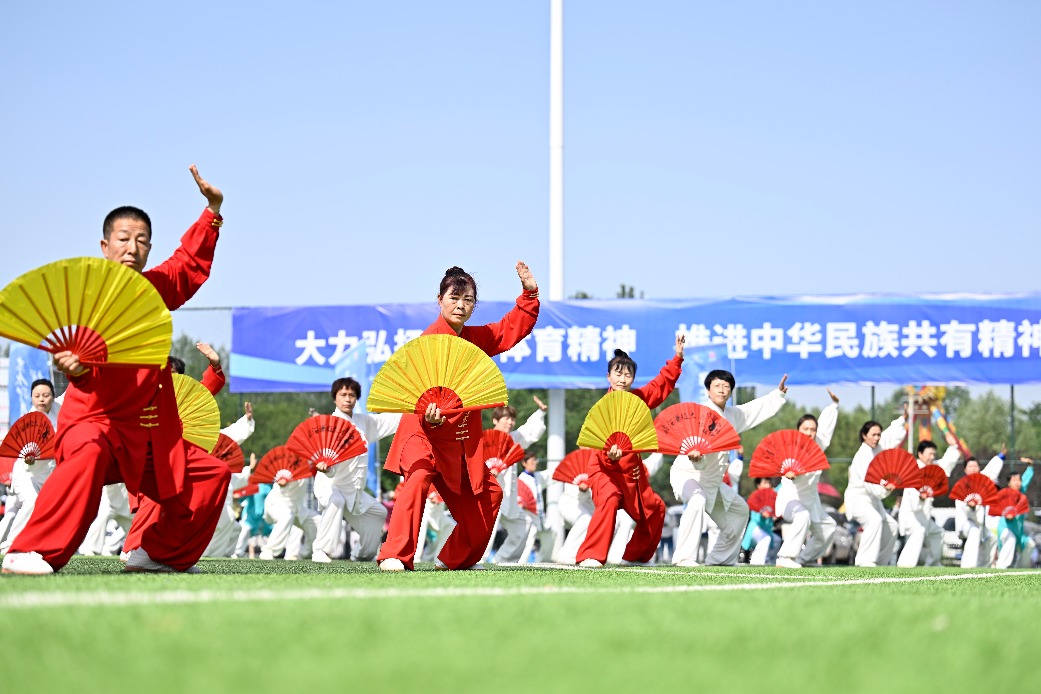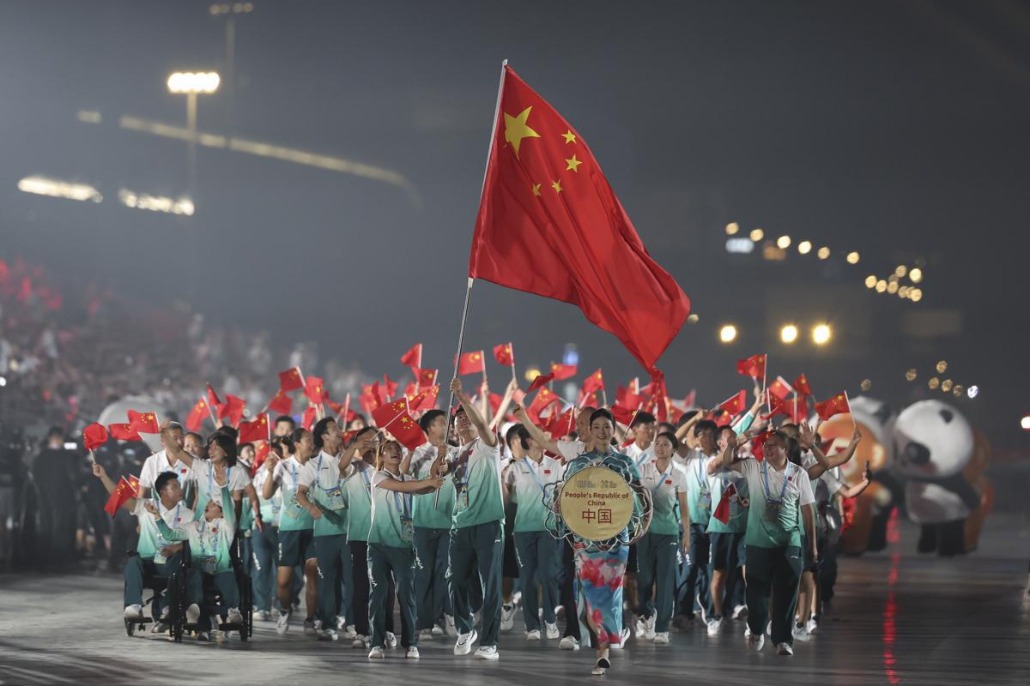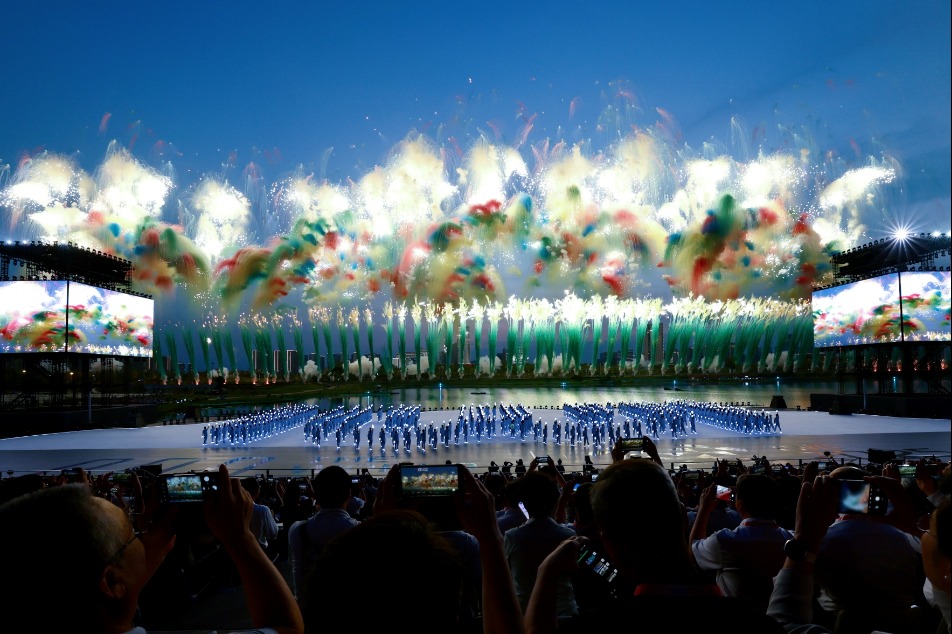'Royal robe' a Milan fashion sensation

Nanjing exhibits brocade favored by emperors at Expo, even using it in haute couture
The ancient Chinese city of Nanjing is unveiling its cultural gems to a global audience at the Milan Expo in an effort to make a connection between traditional Chinese wisdom and modern Western audiences.
Nanjing Week, through July 14, includes an exhibition in a dedicated pavilion in the center of Milan, accompanied by a fashion show and the exhibition of brocade.
| Guo Jun, a renowned yunjin craftsman. at work inside City Pavilion, Milan. Photos by Cecily Liu / China Daily |

Activities focus on the theme of yunjin, an ancient Chinese weaving technique originating from Nanjing. The technique produces elaborately designed brocades. While traditionally this technique was limited to the clothes of the Chinese royal family, today its use is more widespread, producing beautiful clothing for modern consumers in China.
Pan Guping, secretary-general of the Nanjing Week Organizing Committee of the Milan Expo, says Nanjing chose yunjin to be the theme of its exhibition because it represents Nanjing's deep cultural history and has a relevance to contemporary audiences.
"When Western viewers see yunjin, they are amazed by it. But we worked hard to craft an exhibition that would allow them to understand it, and to build on its modern day relevance," Pan says.
Nanjing's yunjin brocade has a history dating back 1,600 years, when the city of Xi'an sent its brocade craftsman to Nanjing, introducing the skill to the southern cities of China.
Gold, silver, peacock feathers and silk yarns are basic materials, and one day's hard work by two deft weavers results in only five to six centimeters of it. Therefore, it is said that an inch of yunjin is as valuable as an ounce of gold.
In the old days, it served as a symbol of royal power, but today it stands for the revitalization of rare craftsmanship and for innovation in the field of fashion design. It has also received official recognition, being listed as a Chinese Intangible Cultural Heritage and recorded in UNESCO's Representative List of the Intangible Cultural Heritage of Humanity.
To bring yunjin alive for modern Western audiences, Pan's team decided to present it in three parts, representing its past, present and future.
The past is represented by an exhibition of a dragon robe replica and a live performance of ancient techniques by renowned craftsman Guo Jun.
The dragon robe is traditionally worn by the Chinese emperor, characterized by its elaborate design and large range of colors. The technique is the process that links a drawing to the finished fabric.
The City Pavilion that Nanjing is using has a museum-like setting and is the only pavilion of Milan Expo that is outside the expo center.
To showcase the contemporary relevance of yunjin, Pan's team decided to replicate Italian artist Leonardo da Vinci's famous Mona Lisa using the brocade, so that Western audiences can see a familiar image being created using an ancient Chinese technique.
"When we embarked on this challenge half a year ago, no one knew if it would be a success or not, but we wanted to give it try. But time was very tight, and we had more than 30 craftsmen working around the clock in three shifts to finish it," Pan says.
The finished product uses 70 different types of silk, all of varying colors, to create the depth characteristic of an oil painting. Such a piece of work would typically take one craftsman about 10 years of his life to complete, Pan says.
But the most difficult part is the suspense in the creative process about what the end product will likely be, because yunjin's process of weaving is done while working on the back of a picture, so that no one knows what the picture on the front looks like until it is turned over.
"We finished the entire picture only five days before the opening ceremony of Nanjing Week, and when it was taken off the production line, everyone was curious to see it. It was a very special moment," Pan says.
Also invited to witness the unveiling of the finished work was Xing Jianjian, a professor at the Nanjing University of the Arts, who is an expert in Western oil painting.
"We invited Professor Xing because we wanted an art expert to tell us if we have managed to use yunjin to capture the spirit of Da Vinci's Mona Lisa. He was very much amazed, and said yes we've achieved this impact and that he never knew it would be possible to so accurately represent the essence of Western art using Chinese technique," Pan recalls.
Xing has also said that such a piece of art is very helpful for his students to examine Da Vinci's work in a more detailed way, because it is created on a much larger scale and allows many of the details to be clearly seen.
The brocade portrait was unveiled to an Italian audience on July 7 at Leonardo da Vinci's Vineyard, a symbolic venue where the great Italian artist once worked. Pan's staff also decided on a fashion show featuring yunjin on July 13 at La Pelota in Milan. The clothes to be presented at the fashion show are designed by leading Chinese haute couture figure Lawrence Xu. Included are about 40 dresses made from yunjin.
The models will walk in a curved path to represent the feeling of water flowing in Nanjing's Qinhuai River, with the effect heightened by lighting.
The design of many of the garments shows Western influence, but some pieces distinctly represent Chinese culture, including pieces that a Chinese bride would wear.
The fashion show is accompanied by a live performance by renowned Chinese singer Gong Linna and her German husband Robert Zollitsch, better known as Lao Luo to Chinese audiences.
Pan says organizers hope the exhibitions will help Western audiences understand and appreciate yunjin, and that private companies and designers will see opportunities to make yunjin products more widespread globally.
Nanjing officials were accompanied by representatives of about 30 companies from the city during Nanjing Week, so Pan's team planned a forum in Milan on July 10 and another in Florence on July 14 for the company officials to meet with Italian creative industry firms to discuss possible business cooperation.
Pan says there is already some collaboration between Nanjing companies and Italian partners, and many Nanjing students are studying art and design in Italy.
Other aspects of the city's culture are also being showcased as part of Nanjing Week. These include furniture, installations, design objects and kunqu opera performances.
"We want to facilitate the process of Chinese culture going global. We give it public sector support, and we help and encourage private sector companies to find cooperation opportunities internationally, and allow them to lead the whole process," Pan says.
"The important thing is to share Chinese culture with Western audiences, in a modest and inclusive way, and avoid being seen as imposing our culture on them," he says. Pan says Nanjing has always been a culturally rich city with creative industries at its heart. He says it should not be a standalone industry but instead work to serve all other industries.
"Creative industries ... help other industries make their products and ideas more relevant and unique, and therefore also help Chinese products to move up the value chain," Pan says.
cecily.liu@chinadaily.com.cn
(China Daily Africa Weekly 07/10/2015 page26)
Today's Top News
- Xi urges all-out rescue efforts following mountain torrents in Gansu
- A Quixotic quest to reindustrialize US
- Grassroots sports events promoting nation's fitness goals
- Major test brings lunar mission closer to reality
- China likely to continue buying gold
- World Games dazzle spectators in Chengdu































